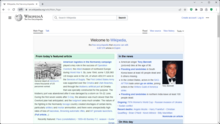Avast Secure Browser
 Avast Secure Browser on Windows 11 | |
| Developer(s) | Avast |
|---|---|
| Stable release(s) | |
| Written in | Mainly C++, among others[5] |
| Engines | Blink, V8 |
| Operating system | Windows, macOS, iOS and Android |
| Size | 488 MB |
| Type | Web browser |
| License | Freeware |
| Website | www |
Avast Secure Browser (formerly Avast! SafeZone) is an Avast Software web browser included for optional installation in the Avast Antivirus installer since 2016, but it is also available on its website. It is based on the open source Chromium project. It is available for Microsoft Windows, macOS, iOS, and Android.
Avast Online Security is an extension for Google Chrome, Microsoft Edge, Mozilla Firefox and Opera browsers that has some similar features to Avast Secure Browser.
Events
[edit]2016
[edit]24 March 2016 – Avast! SafeZone Browser was launched[6]
2018
[edit]6 April 2018 – Renamed to Avast Secure Browser and revamped[7]
History
[edit]Initially, Avast Secure Browser was bundled with paid versions of Avast Antivirus. In March 2016, Avast started bundling it with the free version as well.[8] Avast Secure Browser was originally called "SafeZone" before being revamped and rebranded as "Avast Secure Browser" in early 2018.[9]
Before the revamp and rename, SafeZone's design was similar to that of the Opera browser.[10] SafeZone turned on automatically when the user visited financial or shopping sites to conduct online transactions.[11]
In December 2015, Tavis Ormandy identified a security vulnerability that could allow hackers to insert malicious JavaScript code into the browsers of Avast SafeZone Browser users. Avast quickly deployed a temporary fix and repaired the vulnerability a few days later.[12][13][14]
Features
[edit]- Video Downloader: A plug-in that offers to download videos being watched by the user on selected websites. It allows the user to choose video quality and, in some cases, to download the soundtrack of the video as an audio file.
- Anti-tracking and anti-fingerprinting: The software prevents the collection of information about the user's computer or browsing history that could be used to build a profile of the user.
See also
[edit]References
[edit]- ^ "Avast Secure Browser: Fast VPN - Apps on Google Play".
- ^ "Avast Secure Browser on the App Store".
- ^ "New browser version 118.0".
- ^ "New browser version 119.0".
- ^ "Chromium (Google Chrome)". Ohloh.net. Archived from the original on 9 February 2009. Retrieved 8 February 2012.
- ^ Ot, Anina (1 May 2021). "What Is Avast Secure Browser? Everything You Need to Know". MUO. Retrieved 28 August 2023.
- ^ "Updating from Avast SafeZone Browser to Avast Secure Browser | Official Avast Support". support.avast.com. Retrieved 10 July 2023.
- ^ Salmi, Deborah (24 March 2016). "What is SafeZone Browser?". Avast. Retrieved 13 September 2020.
- ^ Bennett, Brad (6 April 2018). "SafeZone secure web browser rebrands as Avast, adds new features". mobilesyrup.com. Retrieved 12 September 2020.
- ^ Eswarlu, Venkat (24 March 2016). "Avast makes SafeZone browser available to free version users as well". techdows.com. Retrieved 13 September 2020.
- ^ Rubenking, Neil J. (17 December 2013). "avast! Premier 2014 Review". PCMag. Retrieved 13 September 2020.
- ^ Lucian Constantin (5 February 2016). "Serious flaw discovered in Avast's security-focused SafeZone browser". PCWorld. Retrieved 4 May 2019.
- ^ Muncaster, Phil (8 February 2016). "Avast Patches Critical SafeZone Flaw". Infosecurity Magazine. Retrieved 4 May 2019.
- ^ taviso (18 December 2015). "Avast: A web-accessible RPC endpoint can launch "SafeZone" (also called Avastium), a Chromium fork with critical security checks removed". Project Zero. Retrieved 4 May 2019.
